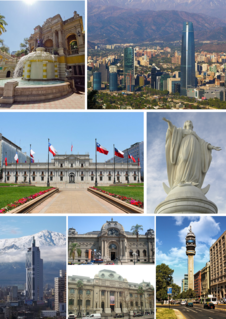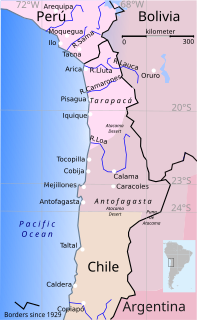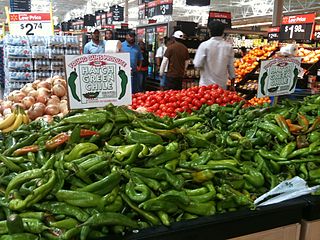
Chile, officially the Republic of Chile, is a South American country occupying a long, narrow strip of land between the Andes to the east and the Pacific Ocean to the west. It borders Peru to the north, Bolivia to the northeast, Argentina to the east, and the Drake Passage in the far south. Chilean territory includes the Pacific islands of Juan Fernández, Salas y Gómez, Desventuradas, and Easter Island in Oceania. Chile also claims about 1,250,000 square kilometres (480,000 sq mi) of Antarctica, although all claims are suspended under the Antarctic Treaty.

Salvador Guillermo Allende Gossens was a Chilean democratic socialist politician and physician, President of Chile from 1970 until 1973, and head of the Popular Unity political coalition government; he was the first ever Marxist to be elected president in a country with liberal democracy.

Santiago, is the capital and largest city of Chile as well as one of the largest cities in the Americas. It is the center of Chile's largest and most densely populated conurbation, the Santiago Metropolitan Region, whose total population is 7 million. The city is entirely located in the country's central valley. Most of the city lies between 500 m (1,640 ft) and 650 m (2,133 ft) above mean sea level.

Patagonia is a sparsely populated region at the southern end of South America, shared by Argentina and Chile. The region comprises the southern section of the Andes mountains and the deserts, pampas and grasslands to the east. Patagonia is one of the few regions with coasts on three oceans, with the Pacific Ocean to the west, the Atlantic Ocean to the east, and the Southern Ocean to the south.

The chili pepper from Nahuatl chīlli is the fruit of plants from the genus Capsicum which are members of the nightshade family, Solanaceae. Chili peppers are widely used in many cuisines as a spice to add heat to dishes. The substances that give chili peppers their intensity when ingested or applied topically are capsaicin and related compounds known as capsaicinoids.

The War of the Pacific, also known as the Saltpeter War and by multiple other names was a war between Chile and a Bolivian-Peruvian alliance. It lasted from 1879 to 1884, and was fought over Chilean claims on coastal Bolivian territory in the Atacama Desert. The war ended with victory for Chile, which gained a significant amount of resource-rich territory from Peru and Bolivia. Chile's army took Bolivia's nitrate rich coastal region and Peru was defeated by Chile's navy.

The Mapuche are a group of indigenous inhabitants of south-central Chile and southwestern Argentina, including parts of present-day Patagonia. The collective term refers to a wide-ranging ethnicity composed of various groups who shared a common social, religious and economic structure, as well as a common linguistic heritage as Mapudungun speakers. Their influence once extended from the Aconcagua River to the Chiloé Archipelago and spread later eastward to the Argentine pampa. Today the collective group makes up over 80% of the indigenous peoples in Chile, and about 9% of the total Chilean population. They are particularly concentrated in Araucanía. Many have migrated to the Santiago and Buenos Aires area for economic opportunities.

The 1973 Chilean coup d'état was a watershed moment in both the history of Chile and the Cold War. Following an extended period of social unrest and political tension between the opposition-controlled Congress of Chile and the socialist President Salvador Allende, as well as economic warfare ordered by US President Richard Nixon, Allende was overthrown by the armed forces and national police.

The Chile men's national football team(Selección masculina de fútbol de Chile) represents Chile in major international football competitions and is controlled by the Federación de Fútbol de Chile which was established in 1895. The team is commonly referred to as La Roja. They have appeared in nine World Cup tournaments and were hosts of the 1962 FIFA World Cup where they finished in third place, the highest position the country has ever achieved in the World Cup. Since the mid to late 1960s, the Elo ratings ranks Chile among the 10 strongest football teams in the world.

Verónica Michelle Bachelet Jeria is a Chilean politician who served as President of Chile from 2006 to 2010 and again from 2014 to 2018, the first woman to occupy the position. After leaving the presidency in 2010 and while not immediately reelectable, she was appointed the first executive director of the newly created United Nations Entity for Gender Equality and the Empowerment of Women. In December 2013, Bachelet was reelected with over 62% of the vote, bettering the 54% she obtained in 2006. She was the first President of Chile to be reelected since 1932.

The Chilean Navy is the naval force of Chile.

Alexis Alejandro Sánchez Sánchez, also known simply as Alexis, is a Chilean professional footballer who plays as a forward for English Premier League club Manchester United and the Chile national team.

The Mecysmaucheniidae are family of araneomorph spiders with 25 described species in seven genera.

The President of Chile, officially known as the President of the Republic of Chile is the head of state and the head of government of Chile. The President is responsible for both the Chilean government and state administration. Although its role and significance has changed over the history of Chile, as well as its position and relations with other actors in the national political organization, it is one of the most prominent political figures. It is also considered as one of the institutions that make up the "Historic Constitution of Chile", and is essential to the country's political stability.

Life on a Thread is a 1945 Spanish comedy film written, directed and produced by Edgar Neville. Neville later modified the film for the stage, with an adaptation of the same name.

Augusto José Ramón Pinochet Ugarte was a Chilean general, politician and dictator of Chile between 1973 and 1990 who remained the Commander-in-Chief of the Chilean Army until 1998 and was also President of the Government Junta of Chile between 1973 and 1981.
Plasmodium schwetzi is a parasite of the genus Plasmodium subgenus Plasmodium.
Contaco is together with Llesquehue River the two main rivers of San Juan de la Costa commune in southern Chile. It runs from east to west and discharges into the Pacific Ocean at the hamlet and beach of Contaco.
Llesquehue is together with Contaco River the two main rivers of San Juan de la Costa commune in southern Chile. It runs from east to west and discharges into the Pacific Ocean at the hamlet and beach of Pucatrihue.

New Mexico chile or New Mexican chile is a group of cultivars of the chile pepper from the US State of New Mexico, first grown by Pueblo and Hispano communities throughout Santa Fe de Nuevo México, the modern peppers were developed by pioneer horticulturist Fabián Garcia at New Mexico State University in 1894, then known as the New Mexico College of Agriculture and Mechanic Arts. The New Mexico chile peppers, which typically grow from a green to a ripened red, are popular in the cuisine of the Southwestern United States, the broader Mexican cuisine, and an integral staple of New Mexican cuisine. The chile pepper is one of New Mexico's state vegetables, and is referenced in the New Mexico state question "Red or Green?"



















